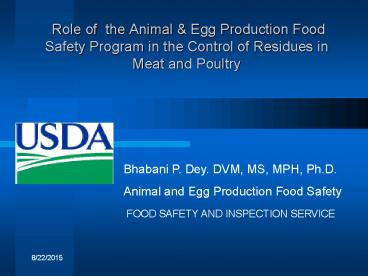Role of the Animal - PowerPoint PPT Presentation
1 / 32
Title:
Role of the Animal
Description:
Quality/Methodology b. Capacity /Capability c ... U.S. FOOD SAFETY REQUIREMENTS FOR EXPORTING MEAT, POULTRY AND EGG PRODUCTS TO THE UNITED STATES Author: – PowerPoint PPT presentation
Number of Views:81
Avg rating:3.0/5.0
Title: Role of the Animal
1
Role of the Animal Egg Production Food Safety
Program in the Control of Residues in Meat and
Poultry
Bhabani P. Dey. DVM, MS, MPH, Ph.D. Animal and
Egg Production Food Safety FOOD SAFETY AND
INSPECTION SERVICE
2
Pathogen Reduction/Hazard Analysis Critical
Control Points System
- PR/ HACCP Final Rule
- (9 CFR Chapter III)
- July 1996
3
HACCP SYSTEM REGULATION
- FOOD SAFETY HAZARD
- (Unsafe for Human Consumption)
- Biological
- Chemical (Agricultural Chemicals /Drugs)
- Physical
4
Determination of Food Safety Hazard
- Possibility of a Hazard
- History of a Hazard
-
5
HACCP Plan Critical Control Points .
- Points
- Steps
- Procedure
- Prevent/ Eliminate/ Reduce
6
Chemical Residues in FSIS Regulated Product
- Drugs (veterinary, illegal)
- Pesticides
- Agricultural Chemicals
7
Challenges
- Adulteration
- Organoleptic Examination
- Farm-To-Table Strategy
-
8
Residue Avoidance Activity
- Animal and Egg Production Food Safety
- (AEPFS) Staff
- State
- Producer Groups
- Universities
- Industrial Organizations
- Consumer Group
9
PR/HACCP Preamble
- Overall Food Safety Strategy
- Regulatory Reform
- Flexibility and Encourage Industry
- Involvement
- Farm-To-Table Approach
10
Food Safety Problem
- Farm -To-Table Continuum
- Hazard at Production, Distribution
- or Consumption
11
Approach Concerns in Residue Control
- Rethinking in a HACCP environment
- Sample for certain chemicals in certain
establishment - FSIS to verify
12
Residue Control in HACCP Environment
- FOLLOW NAS GUIDELINE
- Frame work for control of chemical hazard
- Consideration of management of chemical hazard
HACCP
13
Public Health Protection
- 1. Primary Concern
- Risk Analysis
14
Public Health Prevention
- 2. Hazard Analysis Critical Control Points
- (HACCP)
- is a science based system of process control,
designed to prevent food safety problem during
processing of food rather than to detect them
after they have occurred
15
Considerations
- 3. Tolerance Level of Chemicals
- a. Changes
- b. Authority (FDA, EPA)
16
Considerations
- 4. Sampling Plan for Adequate Prevention
- a. Probability
- b. Random
- c. Alternate
17
Considerations
- 5. Risk assessment
18
Considerations
- 6. Analytical Tool and Testing Capacity
- a. Quality/Methodology
- b. Capacity /Capability
- c. Facilitator (Agency/State)
19
Considerations
- 7. Training
- a. FSIS Veterinarian/ Inspectors
- b. Industry personnel
20
Considerations
- 8. Regulatory Enforcement
- a. Linkage
- b. Amendments
- c. Interagency coordination
- d. New guidance material
21
Considerations
- 9. Information System
- a. Exchange between agencies
- b. Exchange between FSIS and industry
- c. Available resources
22
Considerations
- 10. Priorities
- a. Public Meeting
- b. Solicitation from Organization/CDC
23
Role of the Animal Egg Production and Food
Safety Staff (AEPFS)
- Support the FSIS effort to create an
environment for Farm-to-Table Food - Safety Concept.
24
AEPFSS Approach
- No Regulatory Authority
- 1. Third Party Verified QA program
- (eg. Cull cows)
- 2. Producer Education/Information
- (eg. Video, slide, brochure)
25
AEPFSS Projects
- Cooperative Agreements/Outreach Program
- ( various projects including control of residues
in food animals, poultry and egg) - 24 Partnerships
- 16 Non-assistance with State
- 8 Non-assistance with Universities
26
Approach
- QA certified program for producers
- Live testing of animals
- Encourage sale barn business practices that
address food safety - Influence feed lot practices
- Educate producer about HACCP
27
AEPFS Achievements
- Nebraska/California
- a. Training Material
- b. Training Course
- Nebraska/ Alabama
- a. Animal Food Safety Task Force
- Alabama
- a. Mobile Food Safety Education Display
- Missouri
- a. Education material for trade show
- b. Group Meetings
28
AEPFS Achievements
- Illinois U, Iowa State U, Colorado U
- a. Field Study for Producer Education
- Tuskegee With GA State Extension
- (Video, pamphlet)
- a. Education of Small Farmers
- a. Assistance to Small Producers assistance
- b. Need of Small Producer
- c. Impact of HACCP
29
AEPFS Contacts
- 1. American Sheep Industry
- 2. American Veal Association
- 3. Milk Dairy Beef Quality Association
- 4. National Chicken Council
- 5. National Cattleman Beef Association
- 6. Nation Pork Producer Association
- 7. National Turkey Federation
- 8. United Egg Producers
30
AEPFSS Educational Activity
- 1. Booklet for Residue Avoidance Program/TSC
- 2. Distribute Educational Materials
- 3. Update AEPFSS Book (Yellow Book)
- 4. Federal Guideline Model for a QA Certified
Program - 5. Develop QAP that stress HACCP Principles
31
Future Goals
- 1. Continue Cooperative Agreements with States
and Universities - 2. Work to eliminate hazards that exist in the
farm to slaughter segment
32
Reference
- Federal Register. Nov 28, 2000. Residue Control
in a HACCP Environment 5(229) 70809-70815































